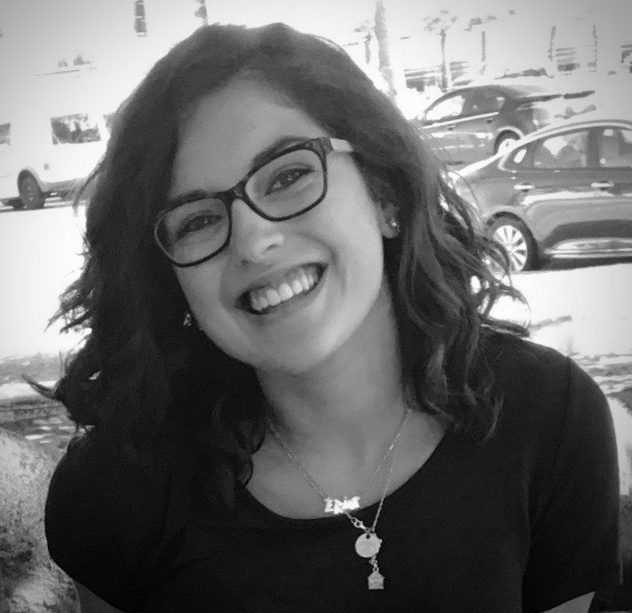 A group of students learning about the Holocaust on the train tracks of Birkenau concentration camp. Photos by Erin Ben-Moche
A group of students learning about the Holocaust on the train tracks of Birkenau concentration camp. Photos by Erin Ben-Moche Nothing can prepare you for a visit to Auschwitz-Birkenau. No amount of movies, books, journals or stories can accurately portray the horrors that changed the course of history forever.
I learned about the Holocaust in Hebrew school and heard about it from my late zayde who was a survivor. But until you see it in person, you have no idea.
During the two days I attended the 31st annual March of the Living on May 1 and 2, the three-kilometer (just under two-mile) march from Auschwitz to Birkenau in Kraków, Poland, my feelings ricocheted from sadness to fear to astonishment. Not only did more than 10,000 people participate this year, we marched on Yom HaShoah — Holocaust Memorial Day.
Some on the trip said it would have been easier “if the weather was worse” —words travelers never say. The beaming sun shone in a blue sky dotted with perfectly white clouds, and the ground was covered in daisies and lilacs. Within the concentration camp, colorful flowers broke through the earth. How could a place filled with such beauty hold such sorrow?
This juxtaposition made the Holocaust feel all the more real to me. Six million Jews weren’t just prisoners on the cloudiest or snowiest of days. They worked, survived and died through the seasonal changes, including the beautiful days.
Many who attended the March of the Living had never been to Poland before, let alone a concentration camp. This year, the coordinators decided to incorporate a tour of the camps prior to the march so that it wouldn’t be so overwhelming.
There are moments you know are coming and prepare yourself for — like entering the crematorium. Tour guides give you the option not to enter if you are uncomfortable. Knowing I had a choice while millions didn’t, I entered.
Anxiety set in immediately as claustrophobia enveloped me in the dark containment room that once held nearly 2,000 people at a time. Trying to find light, I discovered walls scuffed with millions of old scratch marks from those who had tried desperately to escape the Nazi killing machine.
Having the ability to walk out of a gas chamber after only a few minutes adds a perspective that can’t be taught in a classroom. You want to protect everyone so that nobody ever has to go in without having the choice to come out.
There are moments you know are coming and prepare yourself for — like entering the crematorium. Tour guides give you the option not to enter if you are uncomfortable. Knowing I had a choice while millions didn’t, I entered.
But it was also the little things that stayed with me during the march. We passed the famous gates that read “Arbeit Macht Frei” (Work Sets you Free), while many dismissed the trees that stood tall next to it. A tour guide told me the first camp prisoners had planted the four trees immediately adjacent to the gates. So much of the evidence from more than a million people murdered was destroyed, but there were those trees with leaves and branches stretching toward the sky.

A great deal of evidence still remains, though. Two tons of hair behind a glass case cut from an estimated 30,000 people; documentation of direct orders to exterminate so many human lives; luggage and other personal belongings.

Despite it all, several survivors still return to the March of the Living to educate young people. Birkenau survivor Hedy Bohm, 91, from Romania, shared her feelings attending the march for the sixth time.
“As long as I come and see the young people … these thousands of eager and bright Jewish young faces, I’m happy to be with them,” Bohm said. “I’m happy to teach them whatever they need to be ready for life. For years, I think a lot of survivors have had the feeling that times remind us of the 1930s. Unfortunately, I feel the same way, too. … We are unable to learn. History repeats itself. We try to remember, we try to be smarter. We try, and that’s all we can do. Keep on trying.”
March of the Living founder and Co-Chair Dr. Shmuel Rosenman addressed thousands of families, survivors and students ahead of the march, saying, “Today, we proclaim to our enemies with a loud and clear voice: We shall not be defeated! We will return here year after year to raise our voices against anti-Semitism and, indeed, against all forms of racism and hatred. As a survivor of Auschwitz once said, ‘The only one thing worse than Auschwitz is if the world ever forgets that there was an Auschwitz.’ We promise to never allow that to happen.”
The march began with the blast of a shofar. At first, the only sounds were footsteps hitting the dirt floor. Then soft murmurs picked up as groups merged with others sharing stories of survival and family, the most common phrase overheard being, “I’m marching for …” or “I’m marching in honor of …”
I couldn’t help but think I was marching in honor of my zayde.
Erin Ben-Moche was invited as a member of the press by the March of the Living organization to participate in the march.






















 More news and opinions than at a Shabbat dinner, right in your inbox.
More news and opinions than at a Shabbat dinner, right in your inbox.